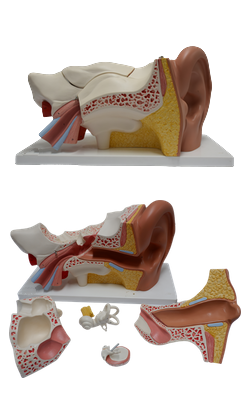Main Model

Middle ear : 8b Handle of malleus

The auditory ossicles form a mobile chain of small bones across the tympanic cavity from the tympanic membrane to the oval window (Latin fenestra vestibuli), an oval opening on the labyrinthine wall of the tympanic cavity leading to the vestibule of the bony labyrinth. These ossicles are the first bones to be fully ossified during development and are essentially mature at birth. The bone from which they are formed is exceptionally dense (hard). The ossicles are covered with the mucous membrane lining the tympanic cavity; but unlike other bones, they lack a surrounding layer of osteogenic periosteum.
Malleus
The malleus (Latin, a hammer) attaches to the tympanic membrane. The rounded superior head of the malleus lies in the epitympanic recess. The neck of the malleus lies against the flaccid part of the tympanic membrane, and the handle of the malleus is embedded in the tympanic membrane, with its tip at the umbo; thus the malleus moves with the membrane. The head of the malleus articulates with the incus; the tendon of the tensor tympani inserts into its handle near the neck. The chorda tympani crosses the medial surface of the neck of the malleus. The malleus functions as a lever, with the longer of its two processes and its handle attached to the tympanic membrane.
Incus
The incus (Latin, an anvil) is located between the malleus and the stapes and articulates with them. It has a body and two limbs. Its large body lies in the epitympanic recess, where it articulates with the head of the malleus. The long limb lies parallel to the handle of the malleus, and its interior end articulates with the stapes by way of the lenticular process, a medially directed projection. The short limb is connected by a ligament to the posterior wall of the tympanic cavity.
Stapes
The stapes (Latin, stirrup) is the smallest ossicle. It has a head, two limbs, and a base. Its head, directed laterally, articulates with the incus. The base (footplate) of the stapes fits into the oval window on the medial wall of the tympanic cavity. The oval base is attached to the margins of the oval window. The base of the stapes is considerably smaller than the tympanic membrane; as a result, the vibratory force of the stapes is increased approximately 10 times over that of the tympanic membrane. Consequently, the auditory ossicles increase the force but decrease the amplitude of the vibrations transmitted from the tympanic membrane through the ossicles to the internal ear.